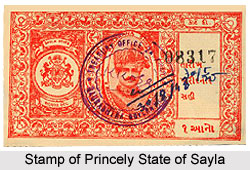 The Princely State of Sayla was one of the prominent princely states of India that were administered by native rulers or Indian princes under the indirect control of the British Government of India. The region covered a total area of 222.1 sq miles and comprised of a total population of 15,352 in the year 1941. The princely state of Sayla, also known as Saela, included around 46 villages and is located in the north central Kathiawar. The region was segregated into a main block of territory which consisted of the state of Sayla and 2 small islands, which were almost completely bounded by Dhrangadhra. The princely state of Sayla was bordered by Muli and Dhrangadhra in the north; by Chuda in the east; by Sudamda Dhandhalpur in the south; by the princely state of Chotila in the southwest; and by Lakhtar in the west.
The Princely State of Sayla was one of the prominent princely states of India that were administered by native rulers or Indian princes under the indirect control of the British Government of India. The region covered a total area of 222.1 sq miles and comprised of a total population of 15,352 in the year 1941. The princely state of Sayla, also known as Saela, included around 46 villages and is located in the north central Kathiawar. The region was segregated into a main block of territory which consisted of the state of Sayla and 2 small islands, which were almost completely bounded by Dhrangadhra. The princely state of Sayla was bordered by Muli and Dhrangadhra in the north; by Chuda in the east; by Sudamda Dhandhalpur in the south; by the princely state of Chotila in the southwest; and by Lakhtar in the west.
The Princely State of Sayla was incorporated as a part of the Baroda Agency, which was sub division of Western India States Agency. Later it became a part of the Eastern Kathiawar Agency and was later included in the Indian state of Gujarat. The courts of the state implemented full civil and criminal jurisdiction, with the customary limitations in respect to capital offenses. The native ruler exercised final and absolute control over the administrative functions of the state. The Raja of Sayla state was an original member of the Chamber of Princes in his own right. Before the eradication of the class system in the year 1925, Sayla state belonged to the Third Class of Kathiawar states.
The Jhala Rajputs were the ruling family of Sayla state, which was established in the year 1751 by the second son Thakor Raysinhji of Dhrangadhra, named Sensabhai. He conquered the region from the Khawad Kathis, his distant kinsmen, who reigned over the area. The native ruler of the state held the hereditary title of Thakor Saheb which was conferred in the year 1927. At this time the jurisdictional powers of the princely state were also augmented.
The former Indian princely state ranked 21st in order of precedence among the states of Western India. The state of Sayla paid annual tribute to the princely state of Junagadh. Sayla state was one of the original constituent members of the Chamber of Princes, a number of smaller states indirectly represented by 12 princes who were elected periodically by themselves. According to the 1943 Attachment Scheme, the princely state was attached to the territory of Dhrangadhra in December 1943. It was one of the fifteen second stage states which initially refused to cooperate with the attaching states.
In the year 1947, the last native ruler of the princely state of Sayla acceded his state to the newly formed Union of India, also known as Dominion of India. At present, Sayla is included as a part of the Indian state of Gujarat.



















